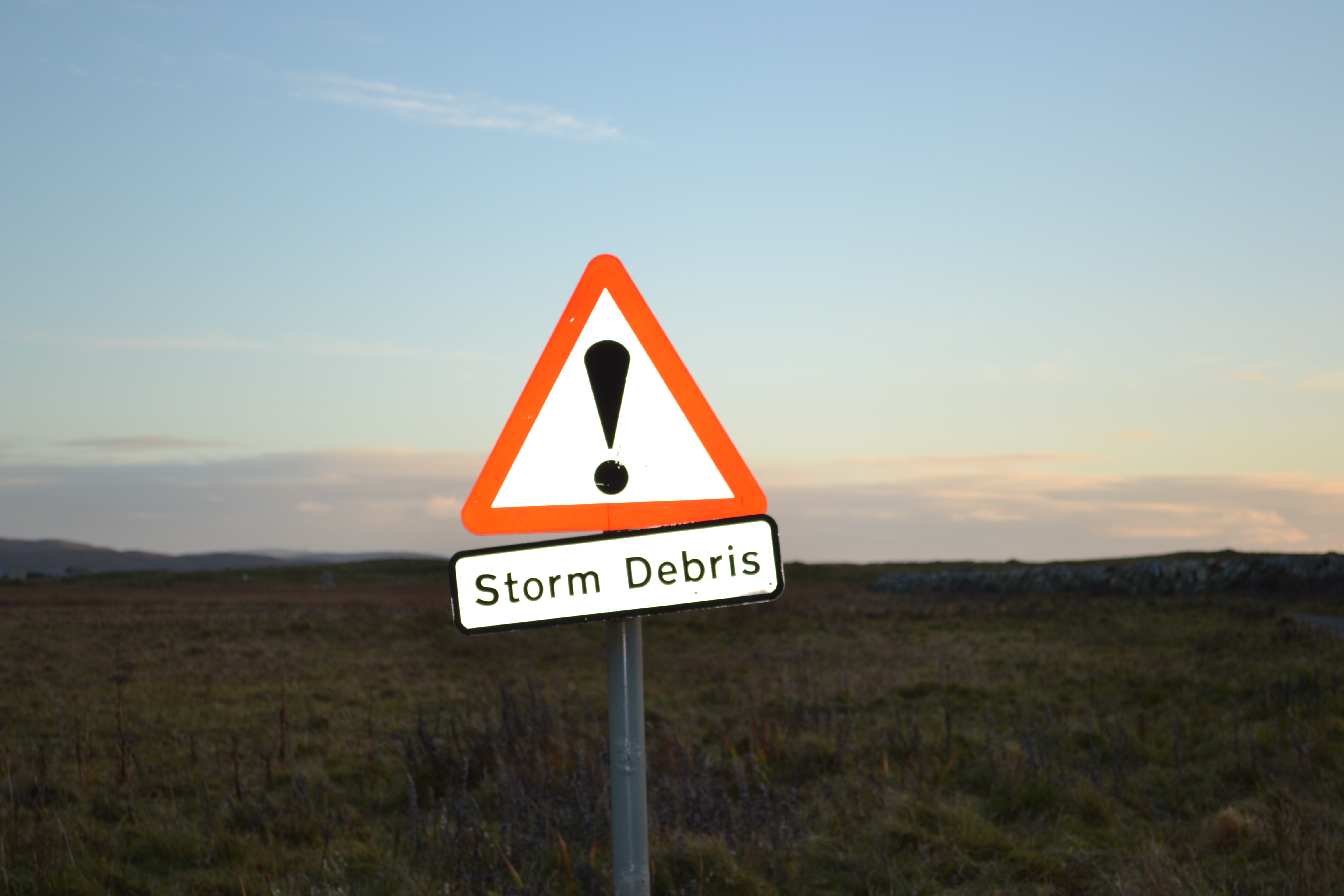
February 10, 2015, by James
Sources in focus – Newspaper reports of extreme weather in the Western Isles in the nineteenth and twentieth centuries (part 2).
Sources in focus – Newspaper reports of extreme weather in the Western Isles in the nineteenth and twentieth centuries (part 2).
‘Sources in focus – Newspaper reports of extreme weather in the Western Isles in the nineteenth and twentieth centuries’ part 1 (https://blogs.nottingham.ac.uk/weatherextremes/2014/11/28/sources-in-focus-newspaper-reports-of-extreme-weather-in-the-western-isles-in-the-nineteenth-and-twentieth-centuries-part-1/) explored the impact of extreme weather on ferries and shipping. Following on part 2 examines the impact of extreme weather on fishing; flooding and high tides; thunder, lighting and snowstorms. It draws on an index of three newspapers: the ‘Highland News’, the ‘Stornoway Gazette’ and ‘The Scotsman’ for the periods 1883-1923, 1917-2004 and 1845-1950, a copy of which has been provided by David Powell, formerly archivist at Tasglann nan Eilean Siar – Hebridean Archives. Also, included are some photographs which came to the attention of researchers on a recent trip to Stornoway.
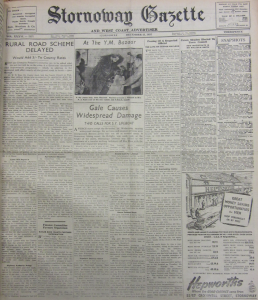
Photograph of a hard bound copy of the Stornoway Gazette, 23 December 1952 held at Stornoway Library. Headline: ‘Gales Cause Widespread Damage.’
Fishing
Extreme weather had a dramatic impact on fishing which was an important part of the economy of the Outer Hebrides. Storms, gales and hurricanes disrupted fishing and frequently resulted in the tragic loss of life as fisherman braved the heavy seas of the North Atlantic. Such disasters had a terrible impact on the close-knit, isolated Hebridean communities. As you would expect, the columns of the newspapers of the Western Isles includes reports of the loss of fishermen and fishing boats. For example, on the 30 December 1894 it was reported that the vessel ‘New Light’ which sailed from the island of Coll with other boats even though the weather was stormy and rough, was lost during a squall with the loss of seven men (Highland News, 20 January 1893). On the 10 December 1892 it was reported that there was almost no fishing in the waters around the Isle of Lewis because of the unsettled weather. Also haddock fishing had been hindered due to the weather. A hurricane on the West Coast of Scotland brought gales from the north, south, east and west for five or six weeks. Such a long lasting storm it was reported was ‘beyond the recall of human memory.’ The crews of the twenty fishing boats making up the herring fleet had to make great efforts to land fish (Highland News, 19 February 1898). On the 26 February 1898 it was reported that fishing was badly affected by stormy weather with damage to nets and other gear. The only positive was the prospect of summer herring fishing (Highland News, 26 February 1898). However, it was later reported on the 4 June 1898 that the summer herring fishing season was delayed because of weather with a total of just 50,576 crans being caught, a decrease of 12,559 compared to the previous year.[1] It was noted that shipments to foreign markets were nevertheless ‘brisk’ (Highland News, 4 June 1898). Again it was reported on the 3 February 1900, that the herring fleet was caught in a storm (Highland News, 3 February 1900) and on the 30 November 1907 trawlers were said to be ‘adrift in the harbour’ (Highland News, 30 November 1907). Aside from fishing, on the 25 June 1904 it was reported that the steamer ‘Elm’ came into Stornoway to board one hundred and fifty fish workers who were to be transported to Shetland, but they refused to embark for two reasons, firstly because their accommodation was insufficient and secondly because of a storm (Highland News, 25 June 1905). The herring fishing fleets were, however, remarkably resilient as on the 14 January 1922 the newspaper reported that the herring fleet was engaged in fishing with ‘grim determination’ regardless of stormy weather (Highland News, 14 January 1922). ‘Fishing notes’ published in the Highland News, 21 January 1922 records:
‘Weather boisterous but not unfavourable – fleet of drifters steadily increasing – new arrivals during the week – catches light – 1546 crans as against 3272 crans in the corresponding week last year – only 65 boats this year as against about 100 last year.’
Furthermore it was recorded:
‘On Monday of last week a drifter put in to Stornoway with a catch of 30 crans but so hostile was the attitude assumed by the other fishermen assembled on the quay that no attempt was made to sell the fish. On the contrary the crew immediately cast off their ropes and sailed for one of the mainland ports, probably deeming discretion to be the better part of valour. The reason for the hostility shown to this crew is that they were suspected of fishing on Sunday.’
The reference to the hostility toward the fishermen thought to have been fishing on a Sunday, the Sabbath alludes to the strict religious culture of the Western Isles. Extreme weather would have reduced the days available for fishing, and it is possible that consequently fishermen did try to fish and land their hauls on a Sunday regardless.
On the 11 January 1946 a severe gale blew in Lewis with winds gusting up to ninety miles per hour. When fishing boats (‘Laurel’, ‘Gladys and Rose’, ‘Coulard Bank’ and ‘Sterlochy’) from the east coast of England were approaching Stornoway harbour, they got a ‘terrific hammering but weathered it successfully’, and a ‘couple of hours later the crews were nonchalantly discharging about a hundred crans of herring on North Beach Quay.’ It was reported that the crews of the fishing boats agreed that it was ‘the worst gale they had ever experienced at sea’, and one member of the crew said it was ‘just as much as that class of boat could stand.’ It was suggested that the gale, although of short duration, was probably the most severe to be experienced in Lewis since the hurricane of 1921 when on that occasion the anemometer at the coastguard station registered a hundred miles per hour before it was carried away by the wind. In the case of the former, the maximum strength of the wind recorded was nine-nine miles per hour and the anemometer ‘lived to tell the tale.’ The newspaper report made reference to a Mr. E.G. Bilham of the Air Ministry who in his book: “The Climate of the British Isles”, recorded only forty three instances between 1909 and 1936 when gusts of over ninety miles per hour were recorded in the British Isles, three of them occurring at the Butt of Lewis in the short period of six years (Stornoway Gazette, 11 Jan 1946).
Later in January 1962, it was reported that herring boats in the Minch had landed poor catches at both Stornoway and mainland ports as Mr. D. Swanney, Fishery Officer, commented that: ‘The weather has interfered throughout the winter but there has been a general scarcity as well and no decent fishing in the Minch since the Christmas holidays.’ Also, it was reported that Dutch luggers which usually came to Stornoway during the winter to klondyke had not arrived. Mr. Kenneth Maciver their agent, said that they were keen to come if there was herring, but two were in Oban and had spent a week there for nothing.[2] It was reported that white fish boats had been almost as badly off as the herring boats as a result of the drawbacks of weather and the scarcity of fish (Stornoway Gazette, 26 January 1962). On the 3 February 1979 it was reported that Stornoway harbour was full with foreign vessels, every berth being occupied by Norwegian and Faroese purse-seiners, which landed their catches of sprats and mackerel.[3] Bad weather forecast had followed the vessels off the North Sea and North Rona fishing grounds and on leaving Stornoway the majority of them then proceeded to the west of St Kilda to fish for mackerel. The twelve vessels which had landed their catch for fish meal processing, discharged almost five hundred tons (Stornoway Gazette, 3 February 1979).
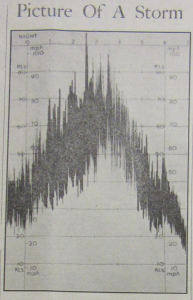
Newspaper cutting of a ‘Picture of a Storm’ as recorded at Stornoway coastguard published in the Stornoway Gazette, 15 February 1952. Winds gusted up to ninety and one hundred miles per hour.
Flooding and high tides
Another type of extreme weather that frequently affected the Western Isles is flooding. The combination of high seas or tides and strong winds could result in large waves breaking over quays, piers and low-lying coastal areas, flooding properties and roads. An impression emerges from newspaper reports that there are similarities with the storms experienced in January and February 2014. Floods were reported in Stornoway in February 1926 (Stornoway Gazette, 4 February 1926) and high tides resulted in the retaining wall apposite house number 16 and some of the road surface being washed away. The sea came over Cromwell Street Quay and into the Market Place and the whole of North Beach curing stations and street was submerged with water up to two feet high in shops and houses in the vicinity of the Crown Inn. Fields at Sandwick Cottage were flooded by the sea and the ‘Alabhama’ buoy floated its anchor and drifted into the harbour (Stornoway Gazette, 4 February 1926). In October 1934 it was reported that moorings broke at Stornoway, a storm sending seaweed into Francis and Point Streets (The Scotsman, 23 October 1934).
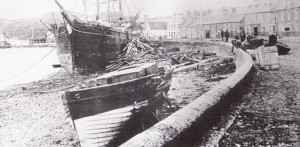
Photograph of South Beach, Stornoway after the Great Storm in October 1882 showing timber strewn on the beach, boats pushed up the beach and against the sea wall.
There were severe floods reported on the 1 September 1933 when a dam burst at Airidh na Lice (1 September 1933) and in 1936 when Creed and Glen were devastated, several bridges being destroyed (11 September 1936). A newspaper report dated 6 January 1950 refers to the restoration of the Glen with a Trust, setting aside the first instalment of £500 for restoring the damage done in Willow Glen by flood water in 1936 (Stornoway Gazette, 6 January 1950). Flooding was also reported on the 15 December 1959 atSouth Beach (Stornoway Gazette, 1959), on the 4 March 1967 at Stornoway as gales swept the islands threatening the water supply (Stornoway Gazette, 4 March 1967) and again on 19 January 1974 (Stornoway Gazete, 19 January 1974). In January 1984 there was much damage caused by storms and this was first reported on the 7 January with a subsequent headline putting the ‘Storm Damage Bill’ at £1.4 million (Stornoway Gazette, 7 and 21 January 1984). Later in the 1980s there was record rainfall at Stornoway, with 2.5 inches being recorded for the month of January (Stornoway Gazette, 28 January 1989) and in the same year on the 18 February high tides (prediction was for 5.25 metres, the actual height was 5.7m aggravated by south-easterly gales) caused extensive flooding in and around Stornoway. Following the storms in 1989 the Member of Parliament for the islands demanded aid to assist with the costs of storm damage (Stornoway Gazette, 18 February 1989). In the 1990s there were further incidences of flooding. On the 16 January 1993 roads were blocked and schools shut because of a week of hostile weather and high tides (Stornoway Gazette, 16 January 1993), on the 10 March 1990 a weighbridge survived floods (Stornoway Gazette, 10 March 1990) and in 1997 it was reported that businesses were hit as the ‘sea pours in’ as North Beach was flooded (Stornoway Gazette, 13 February 1997).
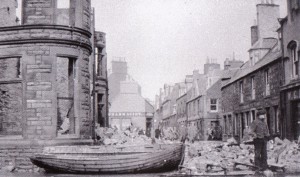
Photograph of the impact of a storm which flooded Stornoway town centre and damaged the ruined town hall.
Other weather extremes recorded: thunder, lighting and snowstorms.
There were other extreme weather events reported in newspapers, these include incidences of lightning and thunder. For example it was reported that on 19 August 1938 a lady from Uig was killed by lightning during a severe thunderstorm in Lewis (Stornoway Gazette, 19 August 1938). Snowstorms also occurred in the winter months. For example in February 1883 two men from the parish of Barvas died from exposure after being caught in a snowstorm while searching for sheep. They were in a group of five from the villages of Arnol and Lower Shader who had left on the Saturday morning (Highland News, February 1884). In February 1945 there was a snowstorm in Lewis that disrupted traffic. It was reported that a vessel had been chartered by the Ministry of Food to sail from Stornoway for Tarbert and Leverburgh on the Isle of Harris in response to an ‘SOS’ (save our souls) from Harris county councillors. A boat from Glasgow reached the port of Tarbet on Friday, by which time Harris had been without supplies brought in by sea for three weeks and two weeks by road from Stornoway (Stornoway Gazette, 2 February 1945). In The Scotsman it was report that a funeral in Lewis had been delayed for two days due to a snowstorm (The Scotsman, 2 February 1945). A headline the following week: ‘The End of the Snowstorm – Three Week’s Siege Over’, marked the end of the snowstorm on 9 February (Stornoway Gazette, 9 February 1945). Later in the following decade there were similar snowstorms reported in the Stornoway Gazette, for example on the 21 January 1955, it was reported that road clearing continued as a result of the ‘Worst snowstorm in Forty Years’ (Stornoway Gazette, 21 January 1955), whilst a letter to the editor from Angus Macsween published in 1959 referred to a snowstorm in 1942 (Stornoway Gazette, 24 March 1959). The 1980s saw further snowstorms, one in November 1981 as: ‘Island Faces Big November Freeze Up’ (Stornoway Gazette, 28 November 1981) and in January high winds and snowstorms led to the headline: ‘Winter Starts to Bite’ (Stornoway Gazette, 26 January 1985). On the 8 May 1997 arctic blasts were reported as having blanketed the town in May snow and a number of seamen were lost as storms struck at shipping (Stornoway Gazette, 8 May 1997). However, whilst the Outer Hebrides does seem to have received considerable snowfall over the years, an interesting article in The Scotsman dating from 5 February 1942 – wartime – outlined that whilst most of Scotland was deep in snow, the Hebrides in contrast enjoyed ‘exceedingly mild weather’, as whilst news of the snow on the mainland had reached the islands, the ‘severity of the storm had not.’ It was reported that one Kent businessman, speaking to his wife from Stornoway was asked how he was surviving the Arctic weather and replied that in fact the weather was mild and spring like. His wife thought he was being ironic and was sympathizing with him when the telephone operator broke into their conversation, stopping them from discussing the weather which was deemed a military secret.
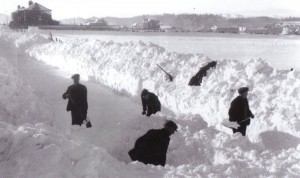
Photograph of workmen clearing snow from Goathill Road, Stornoway in order to allow milk supplies to be transported from Goathill Farm to the town. The winter of 1955 was the worst between 1947-6 and 1962-3.
Finally, one such occurrence which caused debate on the islands was when red dust fell on much of Lewis, Harris and Skye on Sunday evening, covering newly polished cars and streaking windows. The mystery of the red dust was explained to the Portree police by the Meteorological Office at Bracknell as being the result of severe wind storms in North Africa, particularly in the Sahara Desert, which had resulted in fine particles of sand and dust being whipped up into the sky and adhering to cloud formations. Due to prevailing southerly winds these clouds had been blown towards Britain and for some unknown reason the dust particles had fallen in the North West of Scotland. Apart from Skye, Kyle, the west side of Harris and parts of Lewis, the red dust also fell on much of Ayrshire (Stornoway Gazette, 12 March 1977).
Conclusion: parts 1 and 2
As the newspaper index highlights, the effects of extreme weather were wide ranging. Gales, hurricanes and storms frequently resulted in loss of life for fisherman and those at sea, thus having dramatic implications for communities. They could also cause disruption to ferry services and shipping which provided a lifeline between the Outer Hebrides and the Scottish mainland. It could result in food shortages and delays in communications, adding to the sense of isolation and remoteness for the island communities. Extreme weather could have an impact on other aspects of the economy of the islands, not just fishing, but also agriculture. The effect of weather on crops was reported in 1924 (The Scotsman, 17 January 1924) and a modern example was when in 1989 a live power line which fell during a storm at Balallan killed 23 sheep (Stornoway Gazette, 4 March 1989). It could also have an effect on the flora and fauna of the Hebrides. For example in 1908 despite the variation between mild winters and stormy weather, primroses were in full bloom in gardens in Stornoway in early February. During January the recorded morning temperatures were considerably above average, it usually being in the region of 40oF or over, while the night minimum only touched freezing point (32oF degrees) on one or two occasions (Highland News, 8 February 1908). Trees could also be blown down and uprooted. In March 1953 it was reported that a charitable trust was to plant 5000 trees, replacing those that had been damaged in storms (Stornoway Gazette, 10 March 1953). Flooding and high tides could result in damage to beaches and low-lying coastal areas like North and South Beach. Property could be flooded, such as, in Stornoway town, and roads and schools closed. It could also affect community events and disrupt island life. For example it was reported that the attendance of the town and country fair in Stornoway in 1963 was reduced as a result of bad weather (Stornoway Gazette, 3 August 1963). Clearly, newspapers are a really interesting source allowing for inferences to be drawn as to the timing and impact of extreme weather events.
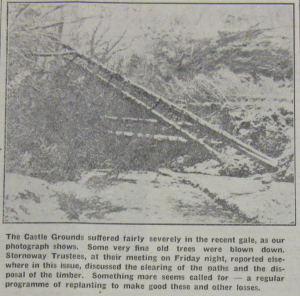
Photograph of trees in the grounds of Lews Castle blown down as a result of severe gales in February 1952 published in the Stornoway Gazette, 1 February 1952.
References
- [1] Cran: a measure of fresh herrings, equivalent to 37½ gallons.
- [2] Lugger: a small sailing ship with two or three masts and a lugsail on each. Klondyke refers to the factory ships that in the late twentieth century processed fresh fish, mainly herring and mackerel, exporting them directly to the European Continent.
- [3] Purse-seiners: a fishing seine that is drawn into the shape of a bag to enclose the catch.
More information
Future research visits will allow for the further study of newspapers. This will enable the research team to develop a chronology for weather extremes in the Outer Hebrides and place the reporting of such events in their wider historical context. Below is a summary of newspapers available for consultation in Stornoway Library:
- Stornoway Gazette on microfilm from 1917 to date, bound volumes from September 1939 to date.
- Highland News on microfilm 1883-1952, bound volumes 1893-1895, 1897-1922 and 1927-1929.
- West Highland Free Press, on microfilm 1972 to date, bound volumes 1975 to date.
- Oban Times, on microfilm 1861-1975.
- Inverness Courier, on microfilm 1817-1885.
- Inverness Advertiser, on microfilm 1849-1885.
- Inverness Courier and Advertiser, microfilm 1885-1975.
The photographs of South Beach, Stornoway after the Great Storm, the impact of a storm which flooded the town centre and damaged the town hall and workmen clearing snow from Goathill Road, Stornoway in 1955 are from Glimpses of Stornoway, edited and compiled by Fred Silver with the support of The Stornoway Trust and the Stornoway Amenity Trust.
For the website of Tasglann nan Eilean Siar – Hebridean Archives see: http://www.tasglann.org.uk/en.
For the website of the Stornoway Gazette see: http://www.stornowaygazette.co.uk/.
No comments yet, fill out a comment to be the first

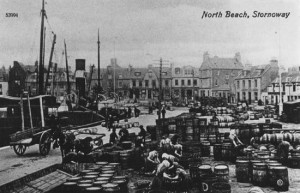


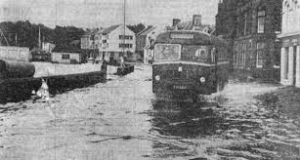
Leave a Reply